Gallery
- Larvae of Psychoides verhuella and Psychoides filicivora
- Psychoides filicivora feeding signs on hart's-tongue fern
- Psychoides verhuella feeding signs
- Psychoides verhuella larval cases
- Psychoides filicivora
- Psychoides verhuella
| Psychoides | |
|---|---|
| Scientific classification | |
| Kingdom: | |
| Phylum: | |
| Class: | |
| Order: | |
| Family: | |
| Genus: | Psychoides Bruand, 1853 |
| Synonyms | |
| |
Psychoides is a genus of moths belonging to the family Tineidae. The type species is Psychoides verhuella first described by, the French entomologist, Charles Bruand in 1853. Bruand also erected the genus. [2]
The moths fly during the day and resemble the Incurvariidae, in which family P. filicivora was first described. [3] They have a flat body and wings are held in a tent-like position. The Psychoides are unusual amongst the Tineidae with the larvae feeding on green plants, i.e. ferns instead of fungi, lichen or dry animal or plant debris. [4]
Psychoides are distributed in the Oriental and Palaearctic regions. Only four species are known, with P. gosari being added to the list in 2007 following the discovery of pupae in Korea from 2004 to 2006. [5] [6]
Psychoides was raised by Charles Braund in 1853 and comes from psukhē – of the soul, i.e. a moth of the family Psychidae and eidos – form, that is from the similarity of this species to moths of the Psychidae. [7]

Anacampsis is a worldwide genus of moth with most found in the nearctic and neotropical regions. It is in the family Gelechiidae. The larvae feed on a range of deciduous trees and shrubs in a rolled or folded leaf, or spun shoot.

The map-winged swift is a moth belonging to the family Hepialidae and has a patchy distribution throughout Eurasia. The species was first described by Charles De Geer in 1778. It was previously placed in the genus Hepialus and some references still place it there.

Eriocrania semipurpurella is a moth of the family Eriocraniidae, found from Europe to Japan and in North America. It was first described by James Francis Stephens in 1835. The species closely resembles Eriocrania sangii and the larvae of both species mine the leaves of birch.

Micropterix aureatella is a moth of the family Micropterigidae found in the Palearctic realm, except for North Africa.

Micropterix calthella, the marsh marigold moth, is a species of moth belonging to the family Micropterigidae. It is found in damp habitats throughout Europe and is also distributed eastwards to central Siberia. It was first described by Carl Linnaeus in 1761 as Phalaena calthella.

Eriocrania sparrmannella also known as the mottled purple is a moth of the family Eriocraniidae, found in Europe and Japan. It was first described by the French entomologist, Louis Augustin Guillaume Bosc in 1791. The specific name honours the Swedish naturalist Anders Erikson Sparrman. The larvae mine the leaves of birch.
Parornix anglicella is a moth of the family Gracillariidae found in Asia and Europe. It was described in 1850, by the English entomologist Henry Tibbats Stainton, from a specimen from Lewisham, Kent.
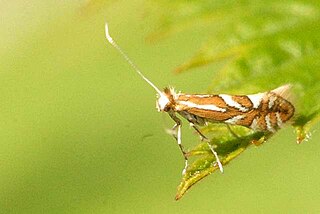
Phyllonorycter oxyacanthae is a moth of the family Gracillariidae found in all of Europe except the Balkan Peninsula. It was described by the German-born Swiss entomologist, Heinrich Frey in 1856. The larvae are known as leaf miners, living inside the leaves of their food plants.

Amphipoea lucens, the large ear or large ear moth, is a moth of the family Noctuidae and is found in most of Europe. It was first described, in 1845, by the German entomologist, Christian Friedrich Freyer, from a specimen, found in Berlin. The larvae feed on the roots and stems of grasses.

Prochoreutis myllerana, Miller’s nettle-tap or small metal-mark, is a moth of the family Choreutidae found in Asia and Europe. Miller's nettle-tap was first described by Johan Christian Fabricius in 1794 from a specimen found in Sweden.
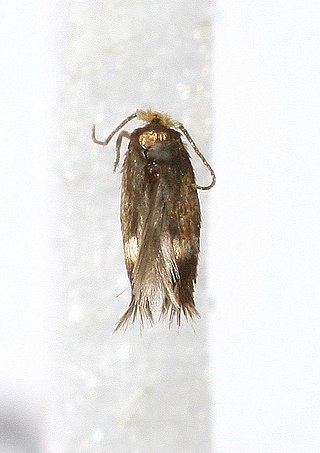
Stigmella microtheriella is a moth of the family Nepticulidae, found in Asia, Europe and New Zealand. The larvae mine the leaves of hazel and hornbeams. It was described by the English entomologist, Henry Tibbats Stainton in 1854 from a type specimen found in England.
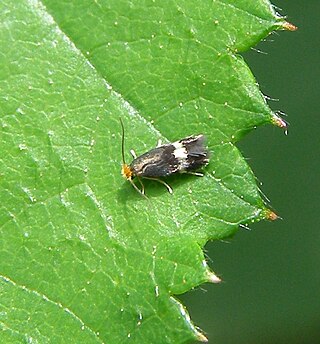
Stigmella aurella is a moth of the family Nepticulidae found in Africa, Asia and Europe. It was first described by the Danish zoologist, Johan Christian Fabricius in 1775. The larvae are leaf miners.

Prochoreutis sestediana, also knowns as the silver-dot metal-mark is a moth of the family Choreutidae found in Asia and Europe. It was first described by Johan Christian Fabricius in 1776 from a specimen found in Kiel, Germany.
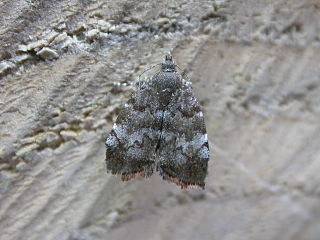
Choreutis pariana, the apple-and-thorn skeletonizer or apple leaf skeletonizer, is a moth of the family Choreutidae. The moth was first described by the Swedish entomologist Carl Alexander Clerck in 1759. It is native to Eurasia and was introduced to New England, USA in 1917.

Acanthopsyche atra, the dusky sweep, is a moth of the family Psychidae. The habitat consists of heath and moorland.

Acanthopsyche is a genus of moths in the Psychidae family. The genus was named by the Dutch entomologist Franciscus J.M. Heylaerts.
Psychoides gosari is a moth of the family Tineidae first described by Seok Kim and Yang-Seop Bae in 2007 from pupae collected from Mount Hwaya in Gyeonggi Province. It is endemic to South Korea.
Psychoides phaedrospora is a moth of the family Tineidae, first described by Edward Meyrick in 1935. It is found in Japan.
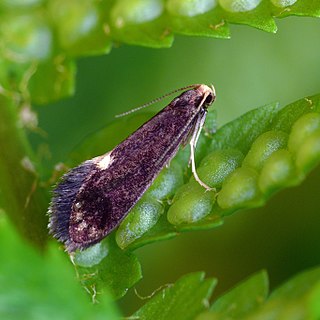
Psychoides filicivora is a moth of the family Tineidae first described by Edward Meyrick in 1937. First found in Ireland in 1909, it is possible that the moth was introduced from imported ferns from Asia. The moth can be found from spring though autumn in a series of generations. The species overwinters as a larva.

Psychoides verhuella is a moth of the family Tineidae found in Europe. It was first described in 1853, by Charles Théophile Bruand d'Uzelle from a specimen from Besançon, France. It is the type species of the genus Psychoides, also raised by Charles Bruand in 1853. The larvae feed on ferns.